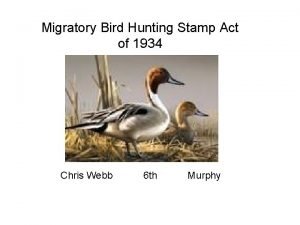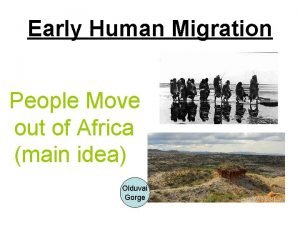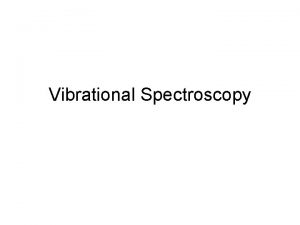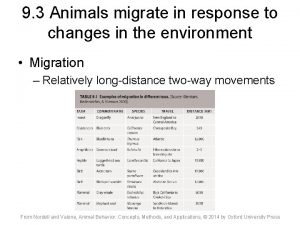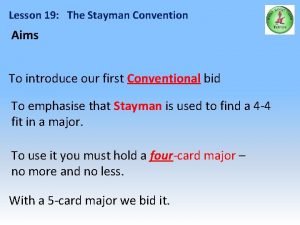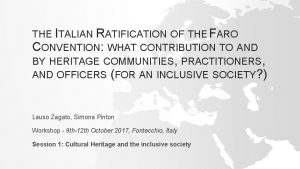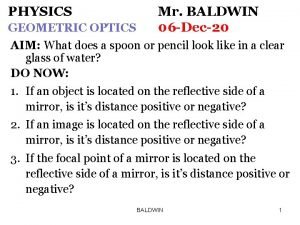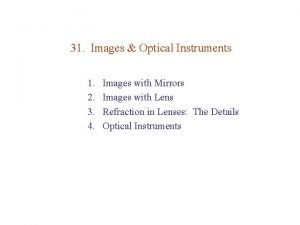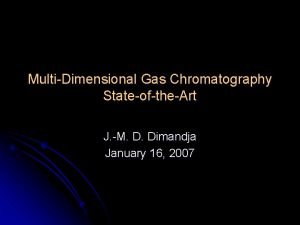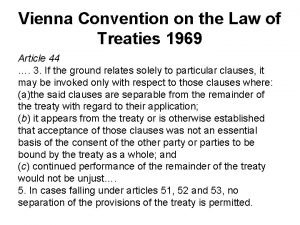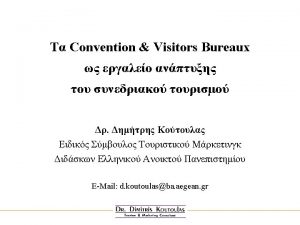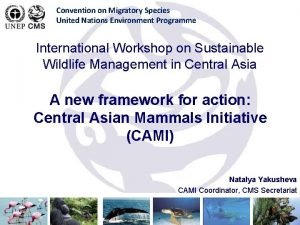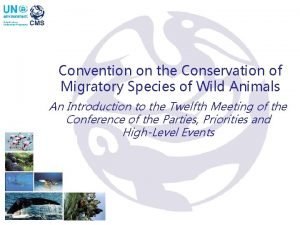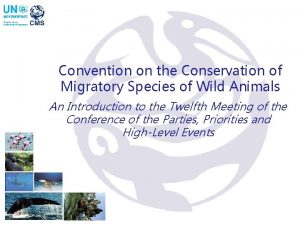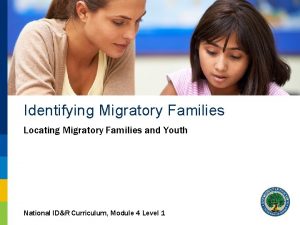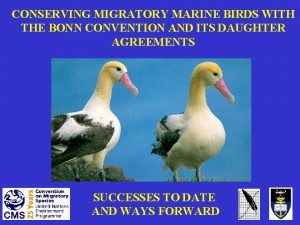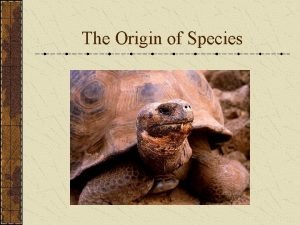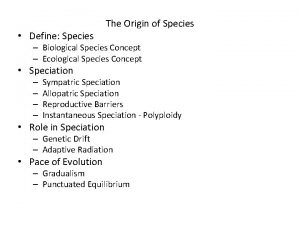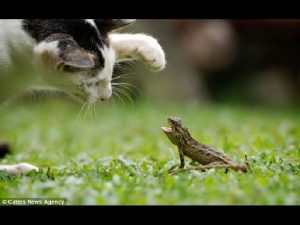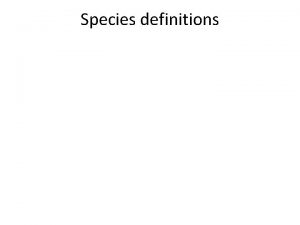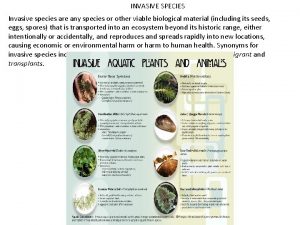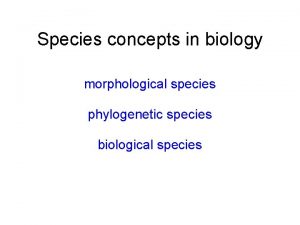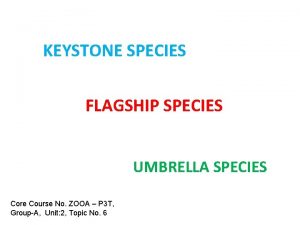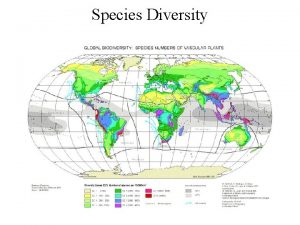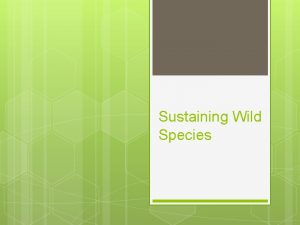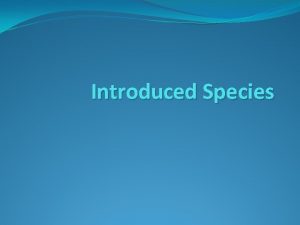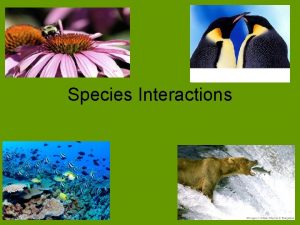Convention on Migratory Species Explain what migration is



































- Slides: 35

Convention on Migratory Species

• Explain what migration is and the reasons why migratory animals must be protected • Define the role of the CMS in the protection of migratory species and its coverage • Identify the instruments of the CMS family • Recall the role and responsibilities of CMS national focal points

• The need of a worldwide agreement on the conservation of migratory species was recognized in the 1972 UN Conference on the Human Environment. • The negotiations for the adoption of the Convention on the Conservation on Migratory Species came to a successful conclusion in June 1979 in a suburb of the German city of Bonn and entered into force in 1983. • It is commonly known as CMS or the Bonn Convention.

Preamble - Protecting migratory species • “Conservation and effective management of migratory species of wild animals require the concerted action of all States within the national jurisdictional boundaries of which such species spend any part of their life cycle

• Article I of the CMS defines the term ‘migratory species’ as “the entire population or any geographically separate part of the population of any species or lower taxon of wild animals, a significant proportion of whose members cyclically and predictably cross one of more national jurisdictional boundaries. ”

The CMS definition does not include: • other forms of movements such as foraging and ranging • migrants that move within the territory of a state but allows for the inclusion of technical migrants such as several bat species and species such as Gorillas that live in frontier

Why shall we protect migratory species? • Migratory species of wild animals are part of the world’s natural heritage. • They form a significant portion of its biodiversity and genetic resources and play a unique role as indicators of ecological change (e. g. climate and pollution). They depend on a range of often fragile habitats.

• There is a growing need to recognize the links between species and their habitats and, in particular, to protect breeding, wintering and stopover sites and migratory corridors. • As migratory species pay no attention to jurisdictional boundaries, effective conservation depends on cooperation between countries.

• CMS is the only global UN-based intergovernmental organization established for the conservation and management of terrestrial, aquatic and avian migratory species throughout their range. • It provides a specialized forum for countries to agree on common priorities and conservation measures and it supports for integrated implementation of biodiversity protection, research and capacity-building projects.

CMS as a framework convention

• Further instruments, tailored to the specific needs of the Range States, can be developed under the CMS for a single species or a group of related species and range from a bilateral agreement to regional or global geographical scope.

These instruments can be: • 1) Agreement: Legally-binding instruments to commit to implement agreed obligations and measures • 2) Memorandum of Understanding: Nonlegally binding instruments to concern common action


• India has also signed non legally binding MOU with CMS on the conservation and management of Siberian Cranes (1998), Marine Turtles (2007), Dugongs (2008) and Raptors (2016).

Raptors • The agreement, also called the Raptors Mo. U, covers 93 species of migratory birds of prey and extends up to 131 range states in the African-Eurasian Region.

Amur falcons

Amur falcons are known to breed in southeast Russia and northern China and migrate west through India and across the Arabian Sea to southern Africa where they spend their winters, making a round-trip of at least 20, 000 km every year, travelling between their breeding and wintering grounds.



Check Bombay Natural History Society Birdlife International Wildlife Trust of india Amur Falcon dance festivals Doyang Reservoir

• Doyang, in Pangti village of Wokha district, witnesses one of the biggest congregation of these migratory birds because of which now Nagaland is a often termed as the ‘falcon capital of the world’.

Other News • The Indian sub-continent is also part of the major bird flyway network, i. e, the Central Asian Flyway (CAF) that covers areas between the Arctic and Indian Oceans • India has also launched the National Action Plan for conservation of migratory species under the Central Asian Flyway


Species Coverage • Appendix 1 - those species threatened with extinction (Range States species are obliged to afford them strict protection ) • migratory species needing or significantly benefitting from international co-operation are listed in Appendix II (basis for establishing instruments – regional or global – under CMS. )

• The CMS Conference of the Parties (COP) can decide to add (or remove) a species from the Appendices backed by reliable scientific evidence. • Any Party can make such a proposal to the COP, which is adopted if supported by two thirds of the Parties present and voting.

National Focal Points • National Focal Points (NFP) are the government-appointed officials with lead responsibility for overseeing and guiding the implementation of CMS or one of its instruments nationally and liaising with the Secretariat or Coordinating Unit and their counterparts in other Member States.

Summary

• CMS covers any movement of wild animals crossing one or more national jurisdictional boundaries y/N

• Parties can designated several national focal points to be responsible for dealing with issues relating to CMS and/or one or more of its instruments y/N

• CMS only addresses the physical barriers and illegal practices in the migration corridors during the migration period Y/n

Institutional Framework and Funding of the CMS Family


Decision-making bodies • The principal decision-making body for the Convention is the Conference of the Parties (COP) which meets once every three years. • In particular, the COP may review and assess the conservation status of migratory species and the progress made towards their conservation.

• India to host 13 th Conference of Parties(COP) of the Convention on the conservation of migratory species of wild animals(CMS) during 15 th to 22 nd February, 2020 News - 08 -February-2019

• The CMS Small Grants Programme is funding a project supporting Tajikistan to lead on transboundary cooperation on Snow Leopards
 Migratory aptitude is greater for
Migratory aptitude is greater for Migratory bird hunting stamp act
Migratory bird hunting stamp act Human migration map
Human migration map Selection rule for simple harmonic oscillator
Selection rule for simple harmonic oscillator Migratory behavior
Migratory behavior Keystone plant
Keystone plant Explain migration
Explain migration Stayman convention
Stayman convention Faro convention
Faro convention Cisco ios naming convention
Cisco ios naming convention Constitutional convention apush
Constitutional convention apush Aapg annual convention
Aapg annual convention Take a large shining spoon activity
Take a large shining spoon activity Geneva convention rules of war
Geneva convention rules of war Constitutional convention compromise
Constitutional convention compromise Line conventions
Line conventions Java package naming convention
Java package naming convention Cidpiec
Cidpiec Explain money measurement concept
Explain money measurement concept Epic structure english
Epic structure english Constitutional convention 1787
Constitutional convention 1787 Convention 108 plus
Convention 108 plus 1951 refugee convention
1951 refugee convention Lens sign convention
Lens sign convention Inductance
Inductance Sign convention for lenses in tabular form
Sign convention for lenses in tabular form Fox cities exhibition center
Fox cities exhibition center Great compromise apush
Great compromise apush Gcx convention
Gcx convention Vienna convention
Vienna convention Detroit convention bureau
Detroit convention bureau Which is not an elizabethan theatrical convention
Which is not an elizabethan theatrical convention Anime conventions san antonio
Anime conventions san antonio Constitutional convention article 5
Constitutional convention article 5 Berne convention
Berne convention Blackwood 3041
Blackwood 3041

